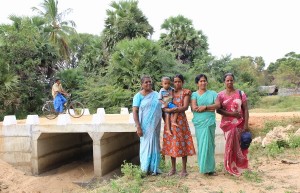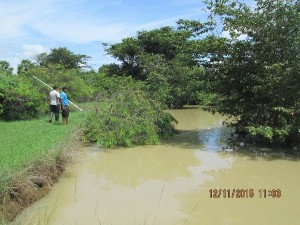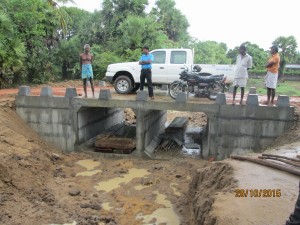Constructing a Storm Water Drainage System in Puliyampokkanai, Kilinochchi
Many villages in the North and East experience flooding during the annual monsoon rains. Internal access roads, mostly constructed with gravel, regularly flood, making accessibility difficult for residents. Day to day life is impacted until flood levels subside and the roads are once again passable. School children and elderly residents are amongst the worst affected, as traversing through muddy and flooded roads can be both difficult and dangerous. Well constructed internal roads and storm water drainage systems are vital to resolve these challenges.
The project for Rehabilitation of Community Infrastructure, Improvement of Livelihoods and Empowerment of Women in the Northern and Eastern Provinces (RCI), funded by the Government of Japan, is supporting the construction of community infrastructure including 10 storm water drainage systems in the North of Sri Lanka. The RCI project is implemented by UN-Habitat through a participatory process with the community in close partnership with the district and local government authorities.
Puliyampokkanai GN Division consists of 424 families with a population of 1,632 people. The majority of residents are engaged in agriculture while others undertake fishing, livestock farming and casual wage labour. From 1996 to 2009, the community was displaced on multiple occasions due to the conflict. Families moved to safe locations elsewhere in the Northern Province, living with host families and in Internally Displaced Camps. In 2011, the families resettled in the village and gradually started to rebuild their lives. As a result of the conflict, this GN division has a large number of vulnerable residents, including 36 people with disabilities and 65 female headed households. Much of the village infrastructure including community buildings, roads and water supply schemes were damaged during the conflict.
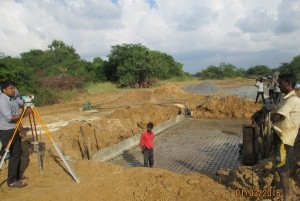
The base for the box culvert under construction.
To identify infrastructure needs of the village, a Community Action Planning workshop was conducted by UN-Habitat in August 2013. The community identified several urgent needs including the need for a storm water drainage structure on Puliyampokkanai Road, a preschool and a community well. The RCI project provided funding for a storm water drainage system amounting to LKR 4,481,370. This intervention was identified as a key priority as the road was prone to flooding during heavy rains, as excess water from the nearby fields and streams flow through this area.
The Puliyampokkanai Women’s Rural Development Society (WRDS) was selected by UN-Habitat to construct the storm water drainage structure, including a small bridge structure for pedestrian and vehicular traffic. In August 2015, the WRDS signed a community contract with UN-Habitat to implement the project. The design for the structure and the Bill of Quantities was provided by UN-Habitat while planning approvals and regularisation of land ownership was facilitated by the Kandawalai Divisional Secretariat.
The storm water drainage structure is 5m in length, consisting of a 1.5m X 1.5m twin cell. The WRDS was responsible for the hiring skilled construction workers and purchasing construction materials. The planning and implementation of the project was driven by the WRDS and the community while UN-Habitat provided technical assistance.
The Puliyampokkanai community and the Rural Development Officer (RDO) worked closely to support the WRDS. The RDO checked expenditure and financial records of the WRDS and approved payments according to the physical progress of work. The Grama Niladhari monitored the progress and assisted UN-Habitat with community meetings. The construction work was completed in October 2015 and the drainage structure, which also functions as a motorable mini bridge, is used daily by the residents.
The RDO of Puliyampokkanai stated “The WRDS closely monitored the construction progress and addressed issues well in time. We also appreciate the training programmes conducted by UN-Habitat on leadership and financial record keeping. Community organizations have gained skills in managing construction related projects. This will inspire them to be more active in their villages”.
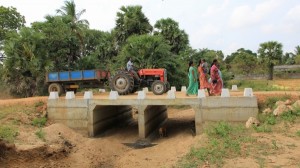
The SWD structure which doubles up as a small bridge is regularly used by pedestrian and vehicular traffic.
Mrs. Rajeswary, the WRDS President stated “This project gave us the opportunity to work with both the community and the Government. We now have a close bond with the community. We are grateful to the Government of Japan for the financial support and to UN-Habitat for guiding us to construct the structure”.
A resident of Puliyampokkanai, discussing the improvements to the village, stated “we are very happy with the drainage system and small bridge. Now the area is clean and very much safer. My daughter uses this road regularly to travel to school, rather than going through neighbouring gardens”.
The RCI Project is a community infrastructure development project, contributing towards the sustainable rehabilitation and reconstruction of the conflict affected Northern and Eastern Provinces. Funded by the Government of Japan and implemented by UN-Habitat, it is assisting communities to overcome the hardships caused by the lack of basic services, whilst rebuilding human capital and empowering women. Implemented in the in the Northern and Eastern Provinces, the project interventions include the construction of community centres, preschools, storage facilities, small irrigation tanks and the rehabilitation of internal access roads and storm water drainage systems.

